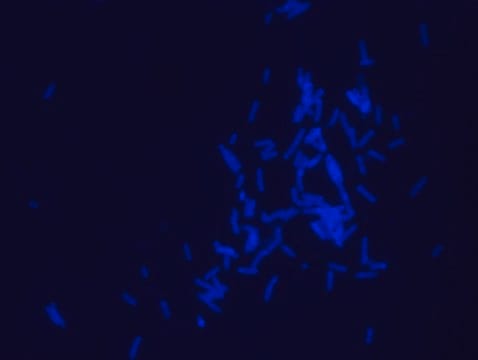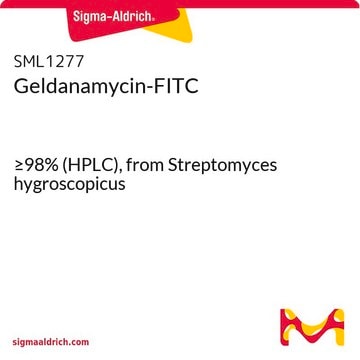推薦產品
一般說明
Rhodamine B labeled Ramoplanin is a fluorescent derivative of Ramoplanin, with a similar mode of action as Ramoplanin. It allows fluorescent labeling of Gram-positive bacteria and their detection by common fluorescent instruments. Ramoplanin is a lipoglycodepsipeptide antibiotic that is produced by the fermentation of Actinoplanes species. Fluorescent antibiotics are obtained by a synthetic conjugation of an antibiotic to a fluorophore.
應用
Fluorescent antibiotics can be used for many applications including:
- Antimicrobial resistance research
- Bacterial visualization and imaging
- Parent antibiotic mode of action research and new antibiotic discovery
- Toxicity studies
- Diagnosis of bacterial infections and tracking their uptake in vivo
生化/生理作用
Ramoplanin blocks the bacterial cell wall biosynthesis by specifically binding to the first sugar of lipid I. N-Acetylmuramic acid thus interfering with peptidoglycan production.
Mode of Action: Is different from the d-Ala-d-Ala that are targeted by vancomycin and shows no cross-resistance with other glycopeptides.
Activity Spectrum: Effective against a broad-spectrum activity against Gram-positive pathogens both in vitro and in vivo including Enterococci, Staphylococci, Bacilli, Streptococci, Listeria monocytogenes, and Gram-positive anaerobes such as Clostridrium difficile. However, Rhodamine B labeled Ramoplanin presents a MIC decrease in the magnitude of two to five orders in bacterial activity in comparison to the parent Ramoplanin.
Mode of Action: Is different from the d-Ala-d-Ala that are targeted by vancomycin and shows no cross-resistance with other glycopeptides.
Activity Spectrum: Effective against a broad-spectrum activity against Gram-positive pathogens both in vitro and in vivo including Enterococci, Staphylococci, Bacilli, Streptococci, Listeria monocytogenes, and Gram-positive anaerobes such as Clostridrium difficile. However, Rhodamine B labeled Ramoplanin presents a MIC decrease in the magnitude of two to five orders in bacterial activity in comparison to the parent Ramoplanin.
特點和優勢
High quality antibiotic suitable for mulitple research applications
分析報告
- Fluorescent microscopy application: Rhodamine B labeled Ramoplanin has excitation/emission wavelength range at 550-560 nm/590-600 nm.
- It is recommended to dissolve the Rhodamine B labeled Ramoplanin in DMSO to a concentration of 2 mg/mL.
- The recommended working concentration in fluorescent microscopy imaging application is 10μM. The mentioned concentration was used for Bacillus subtills staining (see image).
- Aliquots of the DMSO solution can be stored at −20 °C, protected from light for at least one month.
其他說明
For additional information on our range of Biochemicals, please complete this form.
儲存類別代碼
11 - Combustible Solids
水污染物質分類(WGK)
WGK 3
閃點(°F)
Not applicable
閃點(°C)
Not applicable
分析證明 (COA)
輸入產品批次/批號來搜索 分析證明 (COA)。在產品’s標籤上找到批次和批號,寫有 ‘Lot’或‘Batch’.。
Predrag Cudic et al.
Proceedings of the National Academy of Sciences of the United States of America, 99(11), 7384-7389 (2002-05-29)
The peptide antibiotic ramoplanin inhibits bacterial peptidoglycan (PG) biosynthesis by interrupting late-stage membrane-associated glycosyltransferase reactions catalyzed by the transglycosylase and MurG enzymes. The mechanism of ramoplanin involves sequestration of lipid-anchored PG biosynthesis intermediates, physically occluding these substrates from proper utilization
Debra K Farver et al.
The Annals of pharmacotherapy, 39(5), 863-868 (2005-03-24)
To review the pharmacology, antimicrobial activity, pharmacokinetics, clinical applications, and safety of ramoplanin, a lipoglycodepsipeptide antibiotic. Information was obtained from MEDLINE and BIOSIS databases (1984-August 2004) and Oscient Pharmaceuticals using the key words ramoplanin, A 16686, A 16686A, and MDL
Xiao Fang et al.
Molecular bioSystems, 2(1), 69-76 (2006-08-02)
The lipoglycodepsipeptide antibiotic ramoplanin is proposed to inhibit bacterial cell wall biosynthesis by binding to intermediates along the pathway to mature peptidoglycan, which interferes with further enzymatic processing. Two sequential enzymatic steps can be blocked by ramoplanin, but there is
Kittichoat Tiyanont et al.
Proceedings of the National Academy of Sciences of the United States of America, 103(29), 11033-11038 (2006-07-13)
The peptidoglycan (PG) layers surrounding bacterial cells play an important role in determining cell shape. The machinery controlling when and where new PG is made is not understood, but is proposed to involve interactions between bacterial actin homologs such as
M Rhia L Stone et al.
Trends in biotechnology, 36(5), 523-536 (2018-02-27)
Better understanding how multidrug-resistant (MDR) bacteria can evade current and novel antibiotics requires a better understanding of the chemical biology of antibiotic action. This necessitates using new tools and techniques to advance our knowledge of bacterial responses to antibiotics, ideally
我們的科學家團隊在所有研究領域都有豐富的經驗,包括生命科學、材料科學、化學合成、色譜、分析等.
聯絡技術服務








